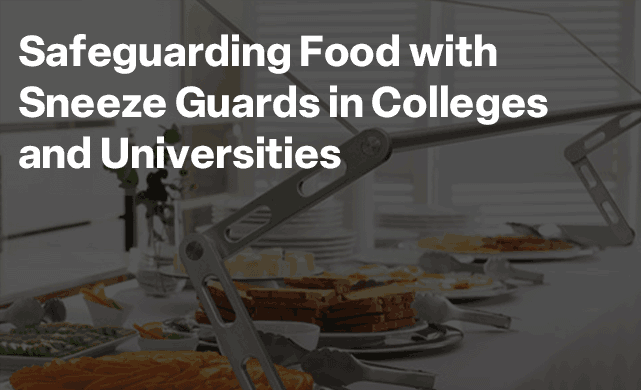Maintaining food safety and hygiene is important to the health and well-being of students and staff in colleges and universities. As the world evolves, so does the approach to food protection. Sneeze guards have emerged as a vital tool to shield food from potential contaminants while allowing diners to view and access their choices. In this blog, we'll explore the importance of sneeze guards and offer practical tips on how to effectively use them to protect food in college and university dining settings.
1. The Role of Sneeze Guards
Sneeze guards serve as a barrier between the food and the surrounding environment, safeguarding it from airborne contaminants such as sneezes, coughs, and other potential germs. Their transparent design ensures that food remains visible and appetizing while preventing direct contact with serving utensils and hands. Understanding the role of sneeze guards is crucial in creating a safer and more hygienic dining experience for all.
2. Where Shields Stand Strong
Strategically placing sneeze guards is a key consideration in food protection. Position them at food stations where students can access their meals, ensuring they are placed at an appropriate height to accommodate diners of all heights. Avoid overcrowding and ensure adequate spacing between the sneeze guards to prevent congestion and promote efficient traffic flow.
3. Regular Cleaning and Sanitization
A clean sneeze guard is an effective one. Implement a regular cleaning schedule to ensure that the guards are kept free from fingerprints, food splatters, and other residues that can obstruct visibility. Use appropriate food-safe sanitizers and cleaning agents to maintain hygiene standards while preserving the integrity of the sneeze guards.
4. Adjustable and Portable Designs
Consider using adjustable and portable sneeze guard designs that can be easily moved to accommodate various dining setups and events. This flexibility allows dining hall staff to customize the serving area based on daily traffic, special occasions, and the number of available food options.
5. Building a Conscious Dining Culture
Incorporate proper training for dining hall staff and student volunteers on the importance of sneeze guards and their correct use. Encourage proactive food safety practices, such as maintaining a safe distance from the food and using serving utensils appropriately. Foster a dining culture that prioritizes the well-being of all diners and upholds the principles of food protection.
6. Aesthetic Appeal with a Purpose
Sneeze guards don't have to be purely functional; they can also enhance the aesthetic appeal of food stations. Consider incorporating custom designs, colors, or branding elements that align with the college or university's identity. When combined with the primary goal of food protection, creatively designed sneeze guards can become an integral part of the overall dining experience.
Safeguarding food with sneeze guards in colleges and universities is a crucial aspect of maintaining a safe and hygienic dining environment. By understanding their role, strategically placing them, ensuring regular cleaning, embracing flexible designs, providing proper training, and creatively incorporating them into the dining space, institutions can create a conscious dining culture that prioritizes the well-being of students, staff, and visitors alike. As a transparent shield of protection, sneeze guards serve not only to protect food but also to foster a sense of security and comfort for all diners in their pursuit of wholesome and nourishing meals.
